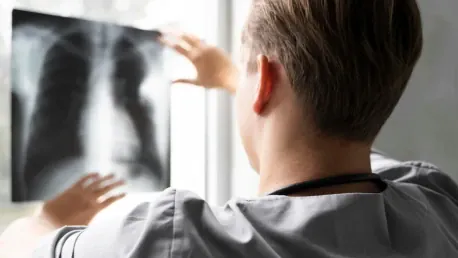The groundbreaking study introduced by researchers at Newcastle University in the UK outlines a revolutionary development in the diagnosis and treatment of respiratory diseases. The focal point is an innovative lung scanning method leveraging a safe, visible gas, delivering unprecedented real-time insights into lung function. This novel technique offers significant advancements in monitoring and treating conditions such as asthma, chronic obstructive pulmonary disease (COPD), and complications arising post-lung transplant. Traditional methods of assessing lung function can be limited, often relying on indirect measurements that do not provide a comprehensive picture of lung health. This new MRI-compatible approach promises to enhance diagnostic accuracy and improve patient care significantly.
The Essence of the Breakthrough
The newly developed imaging technique employs perfluoropropane, a specialized gas observable under an MRI scanner. Patients inhale and exhale this gas safely, allowing researchers to map the efficiency of airflow within the lungs. This technology unveils previously unattainable details regarding poorly ventilated lung areas, providing a clear picture of lung function and facilitating a personalized approach to respiratory disease management. The clarity and precision of this imaging method offer not only improved diagnostic capabilities but also the potential to tailor treatments more effectively by identifying specific areas within the lungs that need attention.
One of the most prominent advantages of this technique is its ability to monitor the effectiveness of treatments instantaneously. According to Professor Pete Thelwall, the team lead and Professor of Magnetic Resonance Physics at Newcastle University, the scans delineate areas within the lungs that either suffer from poor ventilation or show improvements upon treatment. For example, the team demonstrated how scanning a patient using asthma medication could reveal the specific lung regions that benefit most, enhancing our understanding of treatment efficacy. This real-time feedback can be crucial in adjusting treatments promptly, ensuring that patients receive the most effective care possible while minimizing potential side effects from unnecessary medications.
Identifying and Visualizing Lung Defects
Crucially, the imaging technique allows for pinpointing lung areas where airflow is insufficient. This capacity to measure the proportion of well-ventilated versus poorly ventilated lung regions permits a thorough assessment of the impact of respiratory diseases on patients. Moreover, it provides a method to visualize and identify ventilation defects, offering a refined approach to diagnosing and managing lung conditions. By identifying these specific areas of poor ventilation, healthcare providers can develop targeted treatment plans that address the root causes of a patient’s symptoms rather than merely treating the symptoms themselves.
In their flagship papers published in ‘Radiology’ and ‘JHLT Open,’ the team detailed their method’s success in patients suffering from asthma and COPD. They established that the new scanning technique could accurately measure how bronchodilators like salbutamol improve lung ventilation. This ability to quantify treatment outcomes indicates significant potential for these imaging methods in clinical trials, paving the way for evaluating new treatments for lung diseases. The quantifiable data obtained from these scans can also help medical professionals refine existing treatment protocols and develop new therapeutic strategies that can provide better outcomes for patients suffering from a variety of respiratory ailments.
Enhancements in Post-Lung Transplant Care
An additional study focused on individuals who had undergone lung transplants due to severe lung disease. These patients, often susceptible to chronic rejection where the immune system attacks donor lungs, benefited immensely from the detailed imaging provided by the new method. By monitoring air movement over multiple breaths, researchers could discern normal lung function from compromised function indicative of chronic rejection. This early detection capability is crucial in managing post-transplant patients, as it allows for timely interventions that can prevent or mitigate complications associated with immune reactions to transplanted organs.
The team envisions this innovative scanning technique expanding beyond lung transplant recipients to benefit broader clinical management for various lung diseases. The sensitivity and accuracy of these measurements enable early detection of changes in lung function, potentially preventing further damage and facilitating prompt intervention. Proactive monitoring facilitated by this new imaging method could transform how chronic respiratory conditions are managed, shifting from reactive to preventative care models and improving long-term patient outcomes.
Scientific and Medical Recognition
Experts from across Newcastle University, Newcastle upon Tyne Hospitals NHS Foundation Trust, and Sheffield University contributed to this pioneering research funded by the Medical Research Council and The Rosetrees Trust. Their collaborative efforts emphasize the importance of innovative diagnostic tools in transforming respiratory disease management and treatment. The multi-disciplinary approach of this collaborative effort has been critical in ensuring the translation of this technology from research to clinical practice, highlighting the importance of teamwork and shared expertise in driving medical advancements.
The foundational aspect of this breakthrough lies in its ability to visualize lung ventilation in real-time, offering dynamic insights previously unavailable through traditional methods like spirometry. By focusing on the precise mapping of air distribution within the lungs, researchers can detect ventilation defects, assess treatment efficacy more accurately, and monitor disease progression with greater precision. This real-time data is invaluable in providing a more nuanced understanding of respiratory diseases, allowing healthcare providers to make more informed clinical decisions that can significantly impact patient care and outcomes.
Concluding Remarks
The imaging technique crucially allows pinpointing lung areas with insufficient airflow. This ability to measure the proportion of well-ventilated versus poorly ventilated lung regions permits a thorough assessment of respiratory diseases’ impact on patients. It provides a method to visualize and identify ventilation defects, enhancing the approach to diagnosing and managing lung conditions. By spotting areas of poor ventilation, healthcare providers can create targeted treatment plans addressing the root causes instead of merely treating symptoms.
In their flagship papers published in ‘Radiology’ and ‘JHLT Open,’ the team detailed their method’s success in patients with asthma and COPD. They demonstrated that the new scanning technique accurately measures how bronchodilators like salbutamol improve lung ventilation. This ability to quantify treatment outcomes shows significant potential for these imaging methods in clinical trials, paving the way for evaluating new treatments for lung diseases. The data from these scans can help refine existing treatment protocols and develop new strategies, offering better outcomes for patients with various respiratory ailments.









